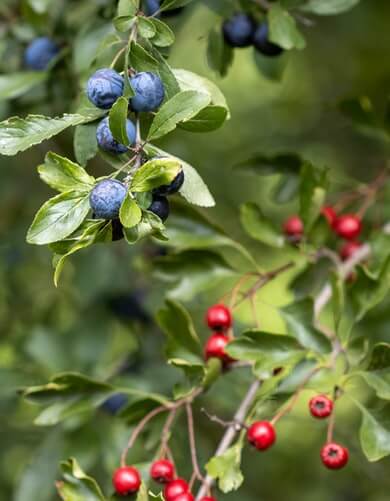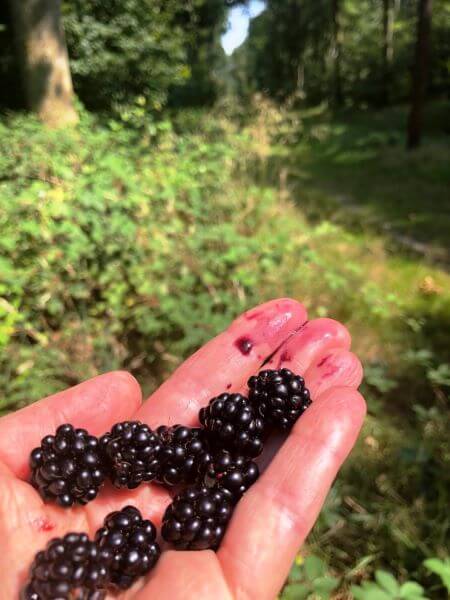
Foraging the Fruits of the Chilterns
It’s late summer, when the hedgerows of the Chilterns are starting to burst into colour with berries and abundant fruit – you can see blackberries and elderberries, crab apples, damsons, rosehips and rowan. It’s a great time for foraging and who doesn’t love a handful of free fresh blackberries on their cereal or a juicy plum?
Late summer and early Autumn have traditionally been a busy time of year for making jams, jellies, chutneys and preserves – it’s time to dig out your Grandma’s special recipe for apple and blackberry crumble or plum jam – or time to make some sloe gin! Best of all, it’s feast time for birds and wildlife too, for whom the hedgerows are a valuable and sustaining food source.
Did you know that the Chilterns has over 2500 miles of hedgerows?

Hedgerows are a key habitat feature of the Chilterns providing pollen, nectar, nuts and berries and seeds throughout the seasons. Hedgerows are rich in bird life, especially songbirds like yellowhammers and corn buntings, and also blackcaps, robins, goldfinches and greenfinches.
Hedgerows are eco corridors, providing shelter for invertebrates, birds and mammals, and avoiding the fragmentation of habitats, which is where wildlife can’t move easily from one ‘island’ of suitable habitat to another. Dormice love hazel hedgerows.
As late summer progresses into autumn, watch the hedgerows whenever you are out and about and notice the beautiful changes in the colours of the leaves as they start to turn.
Safe foraging guidelines
- Remember to only take fruit where it’s plentiful so that you always leave some behind for the wildlife. Don’t take more than you can use.
- Seek permission before foraging on a special habitat with rare species, or a conservation site.
- Never eat anything unless you know what it is. It can be easy to confuse certain berries with other fruit that are poisonous. Sloes for instance look similar to other berries. If you’d like to learn more about wild food ID, these organisations sometimes offer foraging experiences and wild food ID courses locally: David Willis, Backwoods Experiences, Alex Bushcraft – contact them for more details.
- The Woodland Trust has some great seasonal guides to foraging on their website.
What to look for:

Blackberries
Time honoured fun with the kids! Go out armed with a bowl or a Tupperware and search the brambles for the plumpest, juiciest berries. Eat them on your porridge or with yoghurt or cream. Or bake in a blackberry and apple crumble.
Damsons & Plums
Aylesbury used to be famous for its ‘Aylesbury Prune’ damson plums. Wild damsons are still plentiful in the hedgerows and are great for cooking and baking. Alternatively, visit Peterley Manor Farm in Prestwood where you can Pick Your Own plums.
Apples
Don’t let windfall apples go to waste! If you have fallen apples and can’t use them, there are several farms in the Chilterns where you can get your apples pressed including Drovers Hill Farm and Pasture Farm near Princes Risborough, and Chiltern Ridge Farm near Chesham.
Elderberries
Elder (sambucus nigra) – pictured below- can grow into a large tree and is common throughout the Chilterns. Elderberries are thought to have good anti viral properties. They are also fantastic food for birds.

For Foraging Connoisseurs – Hawthorn berries
Wait until October or November and watch out for the sharp spikes! Check out this Hawthorn Ketchup recipe on Great British Chefs.
We’ve pulled together a selection of favourite recipes below. You could also try this recipe for Apple Almond Tart and other apple recipes from our wonderful Chilterns Tring’s own Apple Fayre. The next Apple Fayre will be on 24th October as part of our Autumn Chilterns Celebration of Food and Drink – watch these news pages for more information to follow on festival events soon!
Recipes
Blackberry and Apple Crumble
You can find many. Perhaps you even have a family recipe.
Here’s one from the BBC website!
May Bartlett’s Toffee Apple Pudding
A handed down recipe from a relative of one of our staff members! An indulgent, sticky pudding that is great with custard or cream.
Ingredients:
2 oz suet or vegetarian suet
4 oz self raising flour
1 tsp baking powder
Cold water
Golden syrup
Soft brown sugar
¾ 1b cooking apples
- Mix the suet, flour and baking powder and bind to a stiff dough with water.
- Roll out two thirds of the dough (thinly) to fit and oiled 8 inch flan dish.
- Layer the apples with a sprinkle of brown sugar and lemon juice on top of each of the layers – make three layers.
- Cover with the remaining rolled out dough, sealing the edges firmly over the top. Top liberally with golden syrup and sprinkle with soft brown sugar.
- Bake for 40 minutes at 180 degrees C (gas mark 4).
Damson Jam
Ingredients:
1.8 kg damsons
145 ml water
1.8 kg sugar
(Makes around 6lbs (2.7 kgs) of jam)
- Wash the damsons and remove all the stalks.
- Put into a pan with the water and simmer gently until soft, press them against the sides of the pan occassionally to break them open and release the stones.
Remove the stones. - Test for pectin.
- Add the sugar and stir until dissolved.
- Boil rapidly for about 10 minutes until the jam sets when tested.
- Remove the remainder of the stones as they rise to the surface, and the scum.
- Pot and seal in sterilised jars while still hot.
Elderberry Syrup
A traditional remedy for colds and coughs. Elder is thought to have good anti viral properties. People often take a dessertspoonful a day to prevent colds. Or 10 ml three times a day if you have a cold. Or, pour 30ml into a shot with in the bottom of a glass and have with water like a cordial, or put in some hot water for a hot drink.
Ingredients
(Adjust the quantities proportionately, depending how many elderberries you have collected.)
About 500g of plump, de-stalked elderberries
About 500g white caster sugar
5 cloves
Sliced ginger
A cinnamon stick
- Wash the berries (they’ll then naturally contain some water). Strip the berries off the twigs using a fork – be careful to remove all the stalks from the berries. (There’s a toxic compound in the elderberry seeds and also a small amount in the stalks)
- Put the elderberries in a pan with a about 1cm of water (or just enough to prevent them from burning and sticking.)
- Add the cloves, ginger and cinnamon sticks if you wish.
- Bring this gently to the boil then simmer – watch it so that it doesn’t boil over or stick to the pan. Mash them as they are simmering until they soften into. You can cook them for 20 minutes to half an hour max.
- Cool the mixture enough to strain the juice through a muslin to get remove of the seeds and pulp. You’ll be left with a thickish liquid. Put this back in the pan.
Add the sugar and them simmer it again to make a syrup. - Put the syrup into bottles and it should store well for a year. But you can also bottle it in plastic bottles and freeze it.
Related news
Half-term fun in the Chilterns
With half-term just around the corner, check out what the Chilterns AONB has to offer!
Ridgeway turns 50 on Coombe Hill
Over 70 people gathered on Coombe Hill, Buckinghamshire, on Friday, 29 September, to celebrate 50 years since The Ridgeway National Trail officially opened.
Widening the Welcome
We were delighted to organise an event at Missenden Abbey focussing specifically on how to make visiting the Chilterns more accessible and inclusive.







